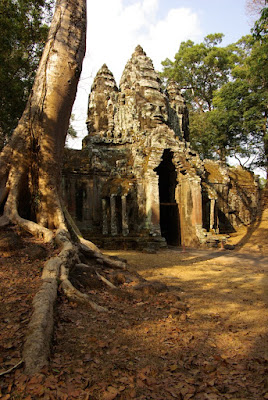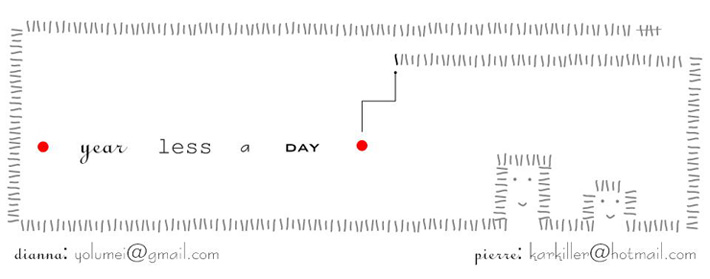We have a 7 day visitor's pass to the temples around Siem Reap (60$US). The temples are at least 10 km away from the city and are over 50 gates, wats, temples, etc located around the city in almost every direction. A person who is truly crazy about temples could easily devote 7 full days to seeing the sites.
When it comes to temple fever, neither Pierre nor I have The Big Crazy and we don't feel the need to see every historic site in the area. Pierre is Quarter to Crazy (or, as his Acadian roots would have it, he's Fou Moins Quart) and I'm Medium-Rare Crazy. This means that while Pierre doesn't need to see every temple in the area, he'd determined to go templing every day (afternoon) while our ticket is good and to get there on his own steam. I, on the other hand, am willing to visit temples almost (but not quite) everyday of our ticket, and reserve the right to take a tuk tuk to the really far temples.
As it turns out, we temple together on Days 86 and 88 (the 2nd to 5th days of our ticket) while I bow out on Days 87 (sick) and 89 (day off) and Pierre explores on his own. Each excursion starts more or less the same way - we have a late breakfast at the guesthouse and listen to the kids at the school next door enjoy their recess - they sound like huge flocks of geese flying south for the winter. Later, we toss portable snacks in our backpacks, fill our bottles with water and pick up bikes from the rental place at the end of the street. After the usual flurry of brake tests, seat adjustments and tire filling we wind our way through traffic towards the temples north of town.
The route starts off busy - we bike past the center of town with its many layers of tuk tuks and taxis, bike past fried mussel vendors walking their wheelbarrow carts, schoolkids on their way to afternoon classes, stop at the traffic light near the city hospital with its food kiosks and picnicking families on the lawn. Not long after that, the city thins out, then the traffic follows and about 5 kilometers from city center the view is mostly asphalt and a medium-height forest. This grows higher by several feet not long after we've shown our passes at the Angkor visitor center and the road gets shadier and quieter. Navy blue banners hang above the road in Khmer and English that say "Tourism Generates Jobs and National Revenue" and "Tourism Creates Prestige in the International Forum."
A few kilometers past the visitor center is a fork in the road; depending on our itinerary that day we travel left or right. From this junction, it's possible to do a Small Circuit (17 km) or Big Circuit (26km) tour of the northern temples. We bike to many individual temples along these circuits during our visits but we never manage to complete the Big or Small Circuit in one day. (Pierre would probably like me to add here that it's not that he couldn't have done the circuits, but that I vetoed it on the days I was out with him - I cried uncle on account of heat and humidity compounded by the use of rusty one-speed bikes.)
Our visits to the temples follow no particular plan and some sites get multiple visits, so the following pictures are grouped by temple but in no particular chronological or geographical order (though I have saved the most impressive, Bayon, for the end of the post).
Ta Prohm
In the top right hand corner of the Angkor Small Circuit lies Ta Prohm - this place is currently most famous for its cameo in Tomb Raider where Lara Croft picks a flower and then tumbles down a hole - the tree is real, the hole is not. (I don't know if this is the tree, but it's a good example):

The ruins are really moody, covered in moss and trees.
 This spot is popular with tourists for its ambiance - at most other temples the jungle has been drastically trimmed back, and there's little evidence that trees once ruled the grounds. In Thailand, the monkeys have a great sense of entitlement - at Ta Phrohm, we learn that trees, too, can feel entitled. A hundred years or more of growing in a place will do that, I suppose. Their bark is silvery in the midday sun and they drape over crumbling walls and roofs..
This spot is popular with tourists for its ambiance - at most other temples the jungle has been drastically trimmed back, and there's little evidence that trees once ruled the grounds. In Thailand, the monkeys have a great sense of entitlement - at Ta Phrohm, we learn that trees, too, can feel entitled. A hundred years or more of growing in a place will do that, I suppose. Their bark is silvery in the midday sun and they drape over crumbling walls and roofs..

 ...and in other places they seem to hold the structures together.
...and in other places they seem to hold the structures together.

The Cambodian temples don't have as many daytime monkeys as the Thai temples did, but we tourists make up for that, climbing over, under and through things to get our shots.
Bantea Kdei
This old Buddhist monastery (from the late 1100s) is located just a few hundred metres from Ta Prohm, and is much less crowded. The grounds are a bit of a mess because so much of the structure has collapsed and been left un-restored. Doorways and walkways are blocked by piles of huge stone that still lie where they fell. The jumbles of rock are huge (the large stones look around 1+ metres x 60+ cm x 30+ cm) but are very stable and those places we can safely walk are clearly marked.



The North and South Gates
These gates lead into Angkor Thom, which is a square, walled temple complex a few kilometers north of Angkor.
The temple is surrounded by a narrow moat - a short bridge takes you across the moat and is lined with stone men holding a naga (5 headed snake). This seems to be a revisiting of the tug-of-war that we saw in the bas-relief at Angkor wat on Day 85. The men on each side of the bridge hold up the body of the snake which makes the balustrade. The demons have hats with three points, while the gods, like the ones below, have hats with just one peak:
 The passageway through the gate is narrow and allows only one vehicle (or elephant) through at a time, though it's posssible to carefully squeeze one tuk tuk and an oncoming bicycle through together if you're feeling stubborn.
The passageway through the gate is narrow and allows only one vehicle (or elephant) through at a time, though it's posssible to carefully squeeze one tuk tuk and an oncoming bicycle through together if you're feeling stubborn.


Preah Palilay
The trees at Ta Prohm (see above) have been allowed to run the temple grounds - here, at Preah Palilay, they are not. More than a half dozen large trees have been chainsawed off near the roots, probably to keep them from either a) falling over and taking the structure down with them or b) "getting in the way" of photos. I hope it's not because of b. The trimming took place sometime in the last year or so - there's still sawdust all over the ground around the stumps.
Phimeanakas
This neglected temple can be reached via one of several run-down gates:

The ruins are not as impressive as some of the others nearby, so the grounds are quiet, except for the small groups of sales-kids offering bootlegged books, t-shirts and soft drinks. Pierre catches one of them in mid-flight below:
 The Terraces
The Terraces Along the main road that cuts through the Angkor Thom grounds are a series of two terraces.
The Terrace of Elephants is the first one you pass as you head north through the grounds. The terrace served as a viewing stand for the king (ie. royal bleachers) whenever he watched parades and ceremonies. Somehow we don't have a picture of the elephant statues, but we do have a picture of a 5-headed horse statue.
 A little further north along the same road is the Terrace of the Leper King. I'm not sure whether this is the historical name of the site or if this is just what the historians call it - the book suggests that there may have been a king with leprosy but that the site was probably a crematorium. The terrace is surrounded by a high-walled, narrow hallway of carvings:
A little further north along the same road is the Terrace of the Leper King. I'm not sure whether this is the historical name of the site or if this is just what the historians call it - the book suggests that there may have been a king with leprosy but that the site was probably a crematorium. The terrace is surrounded by a high-walled, narrow hallway of carvings:
The guidebook devotes about 800 words (ie. a lot) to describing Bayon, which consists of the usual series of gates and levels. The outer edges offer stone walkways and walls...
...unroofed (formerly roofed?) corridors...

 ... and grow upwards into long hallways...
... and grow upwards into long hallways...

...with warm, sunlit corners...

 ... and a few shadowy places...
... and a few shadowy places...

These are all beautiful and moody, and there are countless bas-reliefs (1.2 km worth) along the walls - all this alone would make Bayon a beautiful place to be, but this is not what draws huge crowds here. Instead, people come to see King Jayavarnman VII's face.
The upper reaches of Bayon consist of 54 towers; on each tower are four copies of the same face, one for each side adding up to 216 faces.

The faces are larger than life, with each head at least 6 feet tall. (I was feeling pretty frumpy during our Bayon visit, so Pierre was voted in as our height-reference model that day:)
 Everywhere you go on the grounds you see several of these faces at once, whether straight on...
Everywhere you go on the grounds you see several of these faces at once, whether straight on...

 ...or in profile.
...or in profile.

 Whenever you look up, there's another...
Whenever you look up, there's another...
 ...and they stare at you through windows:
...and they stare at you through windows:

Each one shows the same face with the same expression - calm, smiling, cold. In person, they come off as a little smug. This doesn't come across in the photos so maybe it's a result of seeing so many of the same expression in one small place. Historians aren't really clear on the symbolism of Bayon nor what it was used for (and Jayavarman's not talking - his lips are sealed).

photo credits: P, P, P, P, P, P, P, P, P, P, P, P, D, P, P, P, P, D, P, P, P, P, D, P, D, P, P, P, P, P, P, D, P





No comments:
Post a Comment